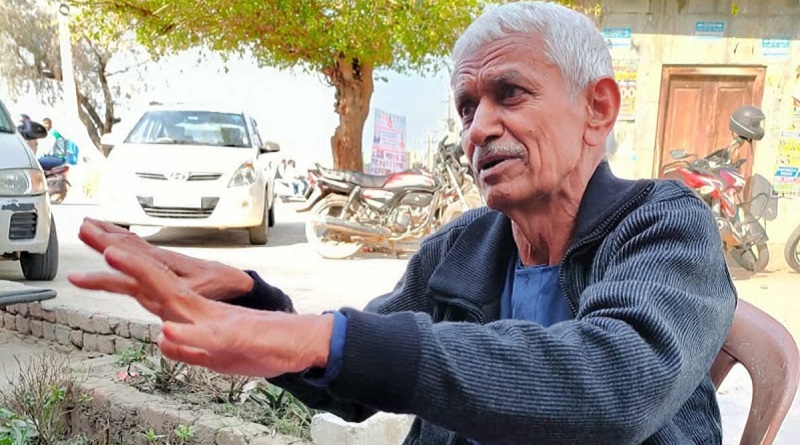Gig Workers – Everywhere, from India to America, from delivery boys to University teachers

By R. Madhu
Last month, delivery partners working for Blinkit — owned by Zomato — went on strike to protest the new payout structure, which saw the reduction of the minimum payout from Rs. 25 to Rs. 15 per delivery. This is in addition to the trimming of (delivery and fuel) incentives offered by the platform.(1)
The strike led to disrupted services in Delhi, Gurugram, Faridabad, Ghaziabad, Noida, and the Greater Noida region, and was met with the permanent shuttering of their “dark stores” in the affected areas and, after multiple rounds of talks failed to yield an acceptable resolution, the disabling of IDs of the protesting workers.(2)
The significance of these protests and many others like them is not to be underestimated, nor viewed in isolation. The so-called “partners” of delivery companies like Zomato, BigBasket, and Swiggy, or transportation companies like Uber and Ola, are members of a growing section of the Indian economy engaged in gig work. Their numbers are presently estimated to be close to 8 million, and expected to grow to over 20 million by the end of this decade.(3)
In this article, we will explore the proliferation of gig work and the various challenges it presents for the labour movement.
Why Gig Work Works, And Why It Doesn’t
Gig work, broadly construed, is a temporary arrangement between two parties: a client looking for a specific service to be carried out, and a worker who provides the service required.(4)
Such arrangements may be reached between clients (who may be individuals or corporations) and individual workers without the use of an intermediary, but is most often observed in highly-skilled white-collar freelancers who opt for non-traditional forms of employment because it gives them more freedom in terms of the time, nature, and place of work. For the purposes of this article, we will largely focus on low-skilled blue-collar gig workers who often rely on platform businesses that facilitate the matching of clients with service providers, the latter often termed “partners” or “independent contractors.”
Platform businesses make money by charging a fee for every transaction between client and service provider that makes use of their technology, and they typically do not own capital assets — for example, Uber doesn’t own the vehicles operated by their driver partners. This allows them to be uniquely disruptive: they can undercut traditional providers of similar services, while at the same time being able to offer (at least initially) very attractive employment opportunities. For example, one survey found that half of the workers surveyed in the food delivery business switched to gig employment due to comparatively low pay in their previous job.(5)
Many also cited regularity of payments as a factor influencing their decision. (6) Incentives, frequently deployed (especially in the early stages) to counter supply shortages, are made very attractive with the intention of capturing as large a market share as possible.
The lack of viable opportunities for low-skilled and organised formal employment may in the short run make gig work seem like a preferable option to working in the informal economy. However, the employer, i.e. the platform business, has no substantive obligation towards the income of the gig worker. (For example, the contract between platform and gig worker is little more than a terms of service agreement, as opposed to a full-fledged employment contract.) (7)
Quasi-client nature
In fact, it is easy to see why, over time, any comparative advantages that gig work offers the worker end up disappearing over time. The same compensations and incentives that benefited the workers earlier are reduced drastically over time owing to the pressure to turn a profit. The same pressures drive platforms to raise commissions. (8) A theme that is common to platform businesses across sectors is that their effort to retain clients — since capturing and retaining a significant portion of the market share means continued earnings — coupled with their efforts to turn profitable make the subsequent immiseration of their “partners” inevitable.
The precarity of gig work was never more clearly on display than during the Covid-19 pandemic — despite delivery personnel categorised as “essential workers,” most saw a significant fall in their earnings, forcing them to borrow or dip into savings. This brings us to another drawback of gig work: the lack of any substantive employment or social security benefits, such as medical insurance, pension funds, etc. (9)
Even matters as simple as taking days off from work — due to illness or otherwise — are effectively penalised since platforms only remunerate their partners based on the number of tasks completed.
It is interesting to note that protests in the transportation industry (led by partners working with Uber and Ola) over the last few years have centred around the difference between promised and actual incomes, where the drivers’ articulation is not unlike that of an aggrieved customer in relation to the platform. This curious feature is telling because it reflects the quasi-client nature of the gig worker himself — the gig worker is a service provider vis-a-vis his relationship with the client, while at the same time being a client of the platform itself. (10)
This dual identity of the gig worker is at the heart of legal battles, not just in India but around the world, regarding the status of gig work, since when manoeuvred skilfully it is effective in disguising what amounts to employment without benefits, and coercive control with the appearance of freedom.
Education as Gig Work, An American Story
“However, even as conditions of precarity and informalisation have come to be the norm, the gig economy marks a different moment, one where precarity is deepened by measures of time. There are no longer short-term jobs spanning weeks or days; there is only the gig, sometimes lasting only minutes, and amplifying with it the experience of precarity.”11
While we have so far solely discussed the gig work associated with platform-based businesses, it is important to recognise essential features of the very same game afoot in other sectors. We will cite just one example of this — the education sector — although there are many others. Here, where once the responsibility for teaching lay with an adequately sized cadre of tenured (permanent) faculty members, universities across the globe today rely on a small pool of contractually employed faculty drawn from a reserve army of trained instructors. Let us start with some examples from the USA.
Massive public divestment, corporatisation and debt financing in higher education in the USA for decades has resulted in reduction in renewals of tenured professorships, and an increase in adjunct (part-time) faculty and graduate students teaching classes. Roughly 40% of faculty are part-time workers. Universities have also adopted a corporatised model of governance with hierarchical decision making to minimise labour costs and an increase in administrators. They also prevent and aggressively practise union busting whenever part-time/adjunct faculty come together to form a union. Unfair contracts, inability to survive on their pay led academic workers all over the US to unionise and strike the most in the past 20 years in 2022.
The biggest strike of 2022 involved around 48,000 academic workers of the University of California across all its campuses and lasted for many weeks. This was the biggest work stoppage ever in a US institution of higher education. The strike won fair contracts for postdoctoral scholars, graduate students and research scientists.
Rutgers university faculty, one of the largest in the USA with around 8,000 members, called for a strike with 94% union vote. This includes full-time and adjunct faculty, professors, instructors, postdoctoral researchers and teachers. They are demanding a living wage and equal pay for equal work. Their fight for a fair contract started in May 2022 and is ongoing.
Graduate students — who often exchange their (teaching) labour for a stipend and financial assistance — in private institutions across the USA are also unionising and preparing to strike. Graduate student workers including Teaching Assistants (TAs) and Research Assistants (RAs) at Boston University, Columbia, Duke, Dartmouth and Yale Universities started organising in the past two years and are actively fighting to form a union and strike against unfair contracts, lack of healthcare and cost of living crisis. However, in many cases, private universities have been sabotaging organising efforts. For example, Duke University voluntarily declined to recognize its graduate student union by denying employee status to its graduate students. Sound familiar?
It is also interesting to note that while in the past, unionising in universities has drawn support from the humanities and social sciences. However, more recently, most TAs and RAs that participate in organising come from the STEM fields.
Similar strikes were organised by the teachers union in Los Angeles, California that constitutes 30,000 teachers aides, special education assistants, bus drivers, custodians and other staff. Teacher shortages in schools across LA are affecting low income districts with 51% staffing positions remaining vacant. Staffing shortages are mainly due to “poverty wages” being provided to teachers with a large proportion of teachers having raises overdue. In the three day strike, workers demanded living wages, healthcare and increased staffing in Los Angeles county schools.
Overall, the increased contractualization, public divestment concurrent with inflation, increased cost of living, rent, etc. has led to massive labour unrest in the US education sector in the past year, quite similar to increased privatisation, rise in contractual workforce and its outcomes observed in higher education in India. For example, in India non-permanent faculty members were 40% of the teaching force at least as far back as a decade ago, and are quite likely worse now.(12) Naturally, similar fissures are erupting. (13) For example, in Delhi University, adhoc faculty have been protesting against displacement, short-term (semester-long) contracts, and for absorption into the regular faculty cadre. In many ways, teaching is also becoming a form of gig work.(14)
Legal Battles and Relief
While agitation surrounding this issue is ongoing in many parts of the world, there has been some success in getting courts to recognise gig workers as employers, although the wins have been few and far between. For example, in the USA, UK, Switzerland, New Zealand, Israel, Mexico, and Spain, courts have recognised that the extent of control that companies like Uber have on their “partners” satisfies the criterion for whether an individual is an employee. (15)
In India, too, the appropriateness of this test as the determinant of employment status was affirmed in Officer In-Charge, Sub-Regional Provident Fund Office v. Godavari Garments (2019), and one might be tempted to conclude based on this that gig workers can soon expect the protections offered to those engaged in more traditional labour arrangements. And while the Code on Wages (2020) does prima facie adopt a broader definition of employee than any of the earlier laws it supersedes, there remain many unanswered questions on the legal front: Many gig workers are forced to work for multiple delivery services simultaneously in order to make ends meet, so while they may be employees, who is their employer? How does one decide the minimum wage when the nature of work is not measured in time or in number of pieces but in number of completed tasks? (16)
As for the Code on Social Security (2020), while it does recognise gig workers as eligible for social security benefits, there are no concrete mandates or clarity on how these benefits are to be coordinated. In this sense, and in many other ways, the law has been unable to keep up with the developments in this rapidly changing labour sector. (17)
Conclusions
Gig work is ubiquitous, and the number of people engaged in gig work is likely to continue growing rapidly — into the many tens of millions — over the next decade. The challenges of organising resistance against this tendency of neoliberal capitalism to isolate workers and intensify their economic insecurity are enormous, although perhaps lessons from attempts to organise workers in the informal sector may be of help. The protests of gig workers clearly demonstrates a growing consciousness and clarity regarding the way capitalism functions. We hope that this resistance can be grown, consolidated, and strengthened over the next few years.
Do read also:-
- Labour in ‘Amrit Kaal’ : A reality check
- Discovering the truth about Demonetisation, edited and censored, or buried deep?
(Writer is a research scholar, who compiled this story.)
References
(1) Rai, A. (2023, April 19). Explainer: The Blinkit gig workers’ strike. Financial Express. https://www.financialexpress.com/industry/explainer-the-blinkit-gig-workers-strike/3053085/
(2) Times of India. (2023, April 18). Blinkit strike: Why Zomato-owned company has shut down some Delhi-NCR Dark stores. The Times of India. https://timesofindia.indiatimes.com/gadgets-news/blinkit-strike-why-zomato-owned-company-has-shut-down-some-delhi-ncr-dark-stores/articleshow/99571544.cms?from=mdr
(3) S, V. (2023, February 11). How India’s gig economy is shaping up, thanks to startups. Business Today. https://www.businesstoday.in/latest/economy/story/how-indias-gig-economy-is-shaping-up-thanks-to-startups-369840-2023-02-11
(4) An excellent introduction to the subject is provided in The Gig Economy: A Critical Introduction by Jamie Woodcock and Mark Graham, UK, Cambridge and Medford: Polity Press, 2020
(5) Tata Institute of Social Sciences (2019). “Understanding Food Delivery Platform: Delivery Persons’ Perspective.” https://tiss.edu/uploads/files/Online_Food_Delivery_Platform.pdf
(6) Surie, A. (2018, March 19). Tech in Work. Economic and Political Weekly. https://www.epw.in/journal/2017/20/commentary/tech-work.html
(7) Deepika M. G., Madhusoodhan M. (2022, July 26). Labour Laws for Gig Workers in the Context of Labour Law Reforms. Economic and Political Weekly 58(30) 38–44. https://www.epw.in/journal/2022/30/perspectives/labour-laws-gig-workers-context-labour-law-reforms.html
(8) PUDR (2021). “Behind the Veil of Algorithms: Invisible Workers.” Peoples Union for Democratic Rights. https://www.pudr.org/behind-veil-algorithms-invisible-workers
(9) Kumar, A. P. (2019). Code on Wages and the Gig Economy. Economic and Political Weekly, 54(34), 10-11.
(10) A. Surie. (2018, November 28). Are Ola and Uber Drivers Entrepreneurs or Exploited Workers? Economic and Political Weekly. https://www.epw.in/engage/article/are-ola-and-uber-drivers-entrepreneurs-exploited-workers
(11) Emphasis ours. Excerpted from Nair, G. (2021, April 6). Between Precarity and Flexibility. Economic and Political Weekly 56(14) 27–29. https://www.epw.in/journal/2021/14/book-reviews/between-precarity-and-flexibility.html
(12) Varma, S. (2013, November 9). Indian higher education: 40% of college teachers temporary, quality of learning badly hit. The Times of India. https://timesofindia.indiatimes.com/india/indian-higher-education-40-of-college-teachers-temporary-quality-of-learning-badly-hit/articleshow/25520250.cms
(13) John, M. (2023, February 9). Adhocism And Its Discontents: Waiting For The Modern Yuyutsu | Countercurrents. https://countercurrents.org/2023/02/adhocism-and-its-discontents-waiting-for-the-modern-yuyutsu/
(14) NotA Collective. (2021, July 22). The Gig Academy Parts 1 & 2. Notes on the Academy. https://notacademy.in/2021/07/23/the-gig-academy-part-1-the-need-for-tenure/
(15) Rai, A. (2023b, April 19). Explainer: The Blinkit gig workers’ strike. Financial Express. https://www.financialexpress.com/industry/explainer-the-blinkit-gig-workers-strike/3053085/
(16) Kumar, A. P. (2019). Code on Wages and the Gig Economy. Economic and Political Weekly, 54(34), 10-11.
(17) Sharma, C. (2019). Aggregators, Driver-partners and the State. Economic and Political Weekly, 54(46), 55-61.
Subscribe to support Workers Unity – Click Here
(Workers can follow Unity’s Facebook, Twitter and YouTube. Click here to subscribe to the Telegram channel. Download the app for easy and direct reading on mobile.)



